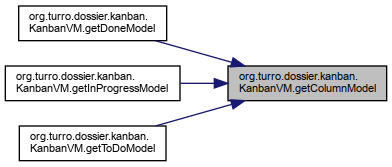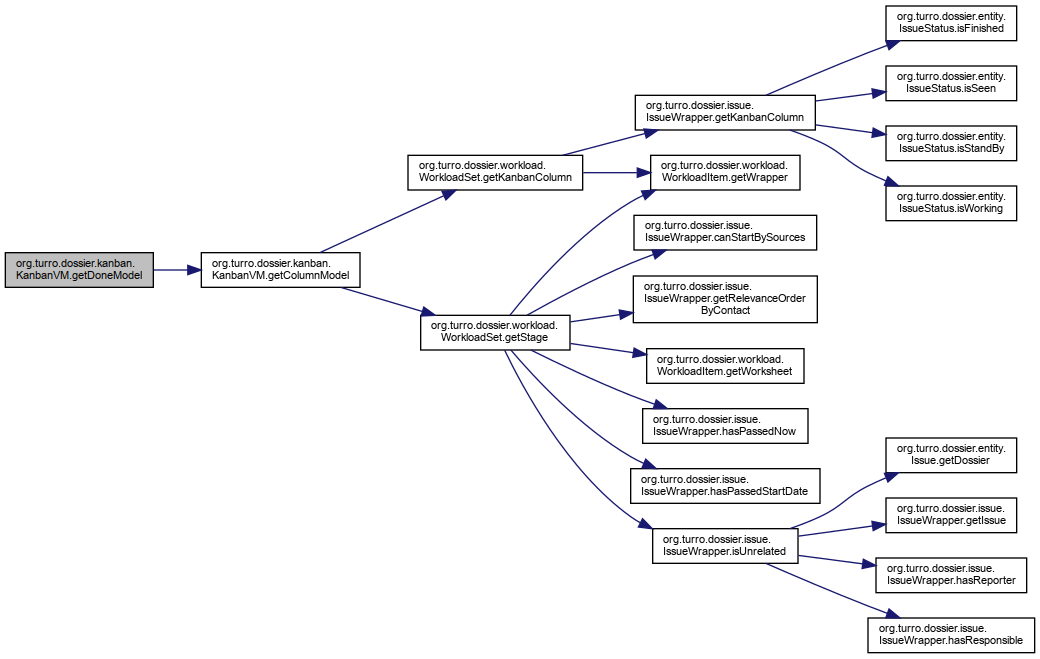- Author
- Lluis Turró Cutiller lluis.nosp@m.@tur.nosp@m.ro.or.nosp@m.g
Definition at line 53 of file KanbanVM.java.
◆ KanbanVM()
| org.turro.dossier.kanban.KanbanVM.KanbanVM |
( |
| ) |
|
Definition at line 58 of file KanbanVM.java.
59 query =
new WorkloadQuery();
◆ addInformation()
| void org.turro.dossier.kanban.KanbanVM.addInformation |
( |
@BindingParam("issue") Issue |
issue | ) |
|
Definition at line 115 of file KanbanVM.java.
116 DossierMenu.addInformation(issue,
null);
◆ getColumnModel()
| GroupsModel<WorkloadItem, Object, Object> org.turro.dossier.kanban.KanbanVM.getColumnModel |
( |
int |
column | ) |
|
Definition at line 197 of file KanbanVM.java.
198 List<List<WorkloadItem>> data =
new ArrayList<>();
199 List<String> headers =
new ArrayList<>();
200 List<WorkloadItem> loading =
null;
202 IssueStage stage =
null;
205 for(
final WorkloadItem item : getModel()) {
206 if(WorkloadSet.getKanbanColumn(item) == column) {
207 IssueStage current = WorkloadSet.getStage(item);
208 if(!(current.equals(stage))) {
210 headers.add(stage.toString());
211 loading =
new ArrayList<>();
214 if(loading !=
null) {
221 return new SimpleGroupsModel<>(data, headers);
◆ getDoneLabel()
| String org.turro.dossier.kanban.KanbanVM.getDoneLabel |
( |
| ) |
|
Definition at line 193 of file KanbanVM.java.
194 return I_.get(
"Done") +
" (" + count[3] +
")";
◆ getDoneModel()
| GroupsModel<WorkloadItem, Object, Object> org.turro.dossier.kanban.KanbanVM.getDoneModel |
( |
| ) |
|
Definition at line 181 of file KanbanVM.java.
GroupsModel< WorkloadItem, Object, Object > getColumnModel(int column)
◆ getInProgressLabel()
| String org.turro.dossier.kanban.KanbanVM.getInProgressLabel |
( |
| ) |
|
Definition at line 189 of file KanbanVM.java.
190 return I_.get(
"In progress") +
" (" + count[2] +
")";
◆ getInProgressModel()
| GroupsModel<WorkloadItem, Object, Object> org.turro.dossier.kanban.KanbanVM.getInProgressModel |
( |
| ) |
|
◆ getParticipant()
| IContact org.turro.dossier.kanban.KanbanVM.getParticipant |
( |
| ) |
|
◆ getSearchValue()
| String org.turro.dossier.kanban.KanbanVM.getSearchValue |
( |
| ) |
|
◆ getSelectedCategory()
| Category org.turro.dossier.kanban.KanbanVM.getSelectedCategory |
( |
| ) |
|
◆ getSelectedDossier()
| Dossier org.turro.dossier.kanban.KanbanVM.getSelectedDossier |
( |
| ) |
|
◆ getStatus()
| Set<IssueStatus> org.turro.dossier.kanban.KanbanVM.getStatus |
( |
| ) |
|
◆ getToDoLabel()
| String org.turro.dossier.kanban.KanbanVM.getToDoLabel |
( |
| ) |
|
Definition at line 185 of file KanbanVM.java.
186 return I_.get(
"To do") +
" (" + count[1] +
")";
◆ getToDoModel()
| GroupsModel<WorkloadItem, Object, Object> org.turro.dossier.kanban.KanbanVM.getToDoModel |
( |
| ) |
|
◆ getTypes()
| Set<IssueType> org.turro.dossier.kanban.KanbanVM.getTypes |
( |
| ) |
|
◆ selectContact()
| void org.turro.dossier.kanban.KanbanVM.selectContact |
( |
@BindingParam("contact") IContact |
contact | ) |
|
Definition at line 96 of file KanbanVM.java.
void setParticipant(IContact contact)
◆ selectEntity()
| void org.turro.dossier.kanban.KanbanVM.selectEntity |
( |
@BindingParam("entity") Object |
entity | ) |
|
Definition at line 81 of file KanbanVM.java.
82 if(entity instanceof Category) {
85 }
else if(entity instanceof Dossier) {
void setSelectedCategory(Category category)
void setSelectedDossier(Dossier dossier)
◆ setParticipant()
| void org.turro.dossier.kanban.KanbanVM.setParticipant |
( |
IContact |
contact | ) |
|
Definition at line 146 of file KanbanVM.java.
void setByParticipant(IContact byParticipant)
◆ setSearchValue()
| void org.turro.dossier.kanban.KanbanVM.setSearchValue |
( |
String |
searchValue | ) |
|
Definition at line 119 of file KanbanVM.java.
void setSearchValue(String searchValue)
◆ setSelectedCategory()
| void org.turro.dossier.kanban.KanbanVM.setSelectedCategory |
( |
Category |
category | ) |
|
Definition at line 128 of file KanbanVM.java.
void setCategory(Category category)
◆ setSelectedDossier()
| void org.turro.dossier.kanban.KanbanVM.setSelectedDossier |
( |
Dossier |
dossier | ) |
|
◆ setStatus()
| void org.turro.dossier.kanban.KanbanVM.setStatus |
( |
Set< IssueStatus > |
status | ) |
|
Definition at line 159 of file KanbanVM.java.
void setStatus(Set< IssueStatus > status)
◆ setTypes()
| void org.turro.dossier.kanban.KanbanVM.setTypes |
( |
Set< IssueType > |
types | ) |
|
Definition at line 168 of file KanbanVM.java.
void setTypes(Set< IssueType > types)
◆ showAttachments()
| void org.turro.dossier.kanban.KanbanVM.showAttachments |
( |
@BindingParam("issue") Issue |
issue | ) |
|
Definition at line 101 of file KanbanVM.java.
102 Application app = Application.getApplication();
103 IssueWrapper iw =
new IssueWrapper(issue);
104 if(app.isInRole(
"issue:show") &&
105 (app.isInRole(
"issue:all") || iw.isFullParticipant())) {
106 IssueAttachTree iat =
new IssueAttachTree();
107 iat.setEntity(issue);
108 iat.setChanges(
new Changes());
109 SelectionDialog.showComponent(Framework.getCurrent().getPage(), I_.get(
"Attachments"),
110 iat,
"80%",
"80%",
null);
◆ showInfo()
| void org.turro.dossier.kanban.KanbanVM.showInfo |
( |
@BindingParam("item") WorkloadItem |
item | ) |
|
Definition at line 64 of file KanbanVM.java.
65 Application app = Application.getApplication();
66 IssueWrapper iw =
new IssueWrapper(item.getIssue());
67 if(app.isInRole(
"issue:show") &&
68 (app.isInRole(
"issue:all") || iw.isFullParticipant())) {
69 DossiersInfo.popup(item.getIssue());
◆ update()
| void org.turro.dossier.kanban.KanbanVM.update |
( |
| ) |
|
The documentation for this class was generated from the following file:



















